Abstract
This study proposes a semi-analytic harmonic modeling method that significantly improves the accuracy and efficiency of complex magnetic field modeling by integrating numerical and analytical approaches. Compared to traditional methods such as the equivalent charge method and finite element method, this approach optimizes the distribution of surface and body charges in the magnetic dipole model and introduces a finite and variable permeability model to accommodate material non-uniformity. Through harmonic expansion and analytical optimization, the method more accurately reflects the characteristics of real magnets, providing an efficient and precise solution for complex magnetic field problems, particularly in the design of high-performance magnets such as Halbach arrays. In this study, the effectiveness of the new modeling method is verified through the combination of simulation and experiment: the magnetic field distribution of the new Halbach array is accurately simulated, and the applicability of the model in the description of complex magnetic fields is analyzed. The dynamic response ability of the optimized model is verified by modeling and simulating the variation of the permeability under actual conditions. The distribution of scalar potential energy with permeability was simulated to evaluate the adaptability of the model to the real physical field. Through the comparative analysis of simulation and experimental results, the advantages of the new method in modeling accuracy and efficiency are clearly pointed out, and the effectiveness of the semi-analytic harmonic modeling method and its wide application potential in the design of new magnetic fields are proved. In this study, a semi-analytic harmonic modeling method is proposed by combining numerical and analytical methods, which breaks through the efficiency bottleneck of traditional modeling methods, and achieves the unity of high precision and high efficiency in the magnetic field modeling of the new Halbach array, providing a new solution for the study of complex magnetic field problems.
1. Introduction
To ensure chip yield, the magnetic levitation stage in the lithography machine needs to perform high-speed and high-acceleration movements during operation. Inaccurate and mismatched magnetic field models can increase the thrust fluctuation of the lithography system, generate uncontrollable reaction forces and disturbance torques, and seriously affect the overall control accuracy of the lithography system. Most existing maglev systems are modeled using finite element analysis or analytical methods. The calculation speed of the finite element analysis method is exponentially related to its error domain, and obtaining an accurate model requires complex and extensive calculations. Conversely, the finite element analysis method can quickly obtain a magnetic field model with errors. The analytical method can only obtain an accurate model of the magnetic field through complex calculations. The above two methods cannot model the high-speed and high-acceleration characteristics of the lithography machine motion table system, which makes it difficult for the subsequent control system to perform well in terms of dynamic performance. To address this issue, a magnetic levitation motion unit based on semi-analytical harmonic modeling was designed using the “planar Halbach array” model as a reference. The significant computational advantages of the semi-analytical harmonic model, combined with its accuracy comparable to that of the equivalent charge analysis method, were utilized to model the magnetic levitation platform. By solving the Poisson equation to obtain the magnetic density distribution generated by all permanent magnets, a fast and accurate magnetic field theoretical model can be obtained while simplifying factors such as end effects and imperfect periodic models. Figure 1 illustrates the magnetic levitation planar motor applied in semi-analytical harmonic modeling.

Figure 1.
Magnetic levitation planar motor.
In order to control the magnetic levitation planar motor system, it is necessary to calculate the rotation position of the cylindrical stator magnet to determine the superimposed magnetic vector generated by the cylindrical magnet and the Halbach array rectangular magnet. These calculations must be performed in real time, otherwise the controller cannot determine how to adjust the cylindrical magnet to produce the desired magnetic flux direction. In order to estimate the Angle of cylindrical stator accurately, it is necessary to build a fast and reliable model. At present, the main modeling techniques include the following:
The first method is the finite element method (FEM) [1], which is a high-precision calculation method that can take into account the nonlinearity of the model. However, when used with six-degree-of-freedom permanent magnet arrays, the modeling speed is usually slower due to the discretization of permanent magnets. This method is more suitable as a validation tool for model optimization than as a real-time modeling method for fast calculations. The second method is the boundary element method (BEM) [2] or the method of Moments (MOM). Both are numerical methods for solving partial differential equations in electromagnetism. These methods are faster than finite element methods because they rely only on the discretization of the boundary and not the volume. However, both methods are completely numerical and, like finite element methods, are not the preferred method for obtaining real-time data. The third method is the equivalent charge method (EQC) [3]. This method of calculating the interaction between permanent magnets is mainly used in passive devices such as gravity compensation systems or magnetic springs. The early equivalent charge method could only be applied to two oppositely parallel magnets. Subsequently, the interaction between permanent magnets with different shapes and magnetization vectors is derived by extending this basis. The magnetic modeling between multiple rotating bodies is further studied and realized. The computational complexity is measured by the number of permanent magnets and the number of function evaluations, and the result is obtained by solving the Lorentz force equation.
When the maglev motion table of the lithography machine is working, the maglev system will move at a speed of more than 1.5 m/s and an acceleration of 60 m/s2. The magnetic suspension motion table of ASML lithography machine.If an accurate harmonic model can be established for the system platform, it is crucial to understand and predict the electromagnetic behavior of the motion table, analyze the internal magnetic field of the actuator, improve the execution efficiency and response speed, and thus improve the engraving accuracy of the lithography machine. Accurate harmonic models also help to identify and reduce possible electromagnetic interference, ensuring the reliability and stability of maglev systems under different operating conditions. The traditional magnetic field research methods mainly include equivalent magnetic circuit method, magnetic network method and electromagnetic field analysis method, and electromagnetic field analysis can be divided into analytical analysis and numerical analysis. The analytical method is divided into equivalent magnetic charge method, equivalent current method and Fourier series method. Because Halbach permanent magnet array has periodic geometric structure, Fourier series method is the most convenient and effective method to analyze. The finite element method of numerical analysis has significant advantages in dealing with complex boundaries, multiple media and nonlinear problems, but it is very time-consuming to deal with complex models. Since the maglev moving table system can be approximated as an open boundary and the movement is not subject to physical constraints, the analytical or semi-analytical modeling technique is superior to the full numerical method considering the computational cost. The harmonic modeling described in references [4,5,6,7] is only proportional to the number of harmonics in a dynamic system and the number of functional assessments, which facilitates modeling of large repetitive systems. In this paper, the semi-analytic harmonic model is used for modeling and compared with other modeling methods to find the most suitable modeling technique for designing and controlling the 6-DOF magnetic suspension motion platform. The semi-analytic harmonic model can not only correct the harmonic phase by rotating the angle of the cylindrical magnetic source, but also change the amplitude of the magnetic source by changing the Z-direction height of the cylindrical magnetic source, which truly realizes the dynamic and high-precision harmonic correction modeling of permanent magnets. The function of the cylindrical magnetic source is to achieve accurate electromagnetic modeling in the traditional Halbach array Figure 1. By rotating and shifting the cylindrical magnetic source (and the combination of magnetic sources), the magnetic field distribution can be accurately calculated, which is crucial for the design and real-time control of the stator of the maglev motion table.
Effective harmonic correction of the original Halbach array can be realized if harmonic superposition can be carried out with additional correction magnetic source. Most of the existing Halbach array models are based on the optimization of parameters such as size, position and polar distance, and then modeling through simplified approximation after determining the basic form, which can not achieve dynamic high-precision magnetic field modeling. In order to solve this problem, A semi-analytic harmonic model in the form of a cylindrical modified magnetic source is used to dynamically correct the magnetic field by means of harmonic superposition of permanent magnets in reference [8,9,10,11,12]. The advantage of using a cylindrical magnetic source is its axial symmetry, and the magnetic field distribution can be determined numerically by calculating the integral on the circular region, which has an absolute advantage in computational efficiency, because when the maglev moving table moves or rotates in a step, only one integral expression needs to be calculated, and there is no need to re-evaluate the model. This method of rotating around the local z axis simplifies the calculation process of the whole system, and can simulate the electromagnetic behavior of the maglev moving table quickly and accurately.
2. Semi-Analytic Harmonic Modeling Method
Combining the core literature in the field, we have added a summary of the evolution of new methods: “The early equivalent charge method was only applicable to magnetic field calculations of two parallel permanent magnets. By simplifying the model by equating the surface of the permanent magnet to a uniform magnetic charge distribution, it was unable to handle scenarios with complex shapes and changes in magnetization direction. Subsequent research extended the modeling adaptation of permanent magnets with different shapes (rectangular and cylindrical) through boundary conditions, and derived the expression of charge distribution under multiple magnetization vectors. However, the computational complexity increased linearly with the number of permanent magnets and did not consider the influence of non-uniform material magnetic permeability. Semi-analytic harmonic modeling is a technique that combines analytical methods and numerical techniques to solve problems involving periodic or quasi-periodic vibrations. The basic principle is to use the harmonic characteristics of the system response, the time part is expressed as a harmonic function (such as Fourier series or complex exponential form), and the governing equation is decomposed into independent parts of time and space by the separation of variables method. The periodic behavior of the time part is solved by harmonic expansion, and the space part is solved by analytical or numerical methods. By substituting the harmonic form into the governing equation and using the Galerkin [13] projection or harmonic balance method [14], the complex problem can be transformed into a set of algebraic equations or differential equations. This method is efficient and accurate, but it has some limitations to nonlinear and aperiodic problems. The technical process of this section is shown in the following Figure 2.

Figure 2.
Technical flowchart.
2.1. Traditional Magnet Array Model
In the traditional Halbach 2D magnet array arrangement, as shown in Figure 3, the prototype magnetic steel array structure is the Halbach 2D magnetic steel array proposed by K. Halbach in 1980 [15]. This paper will analyze and optimize the array arrangement based on this method.
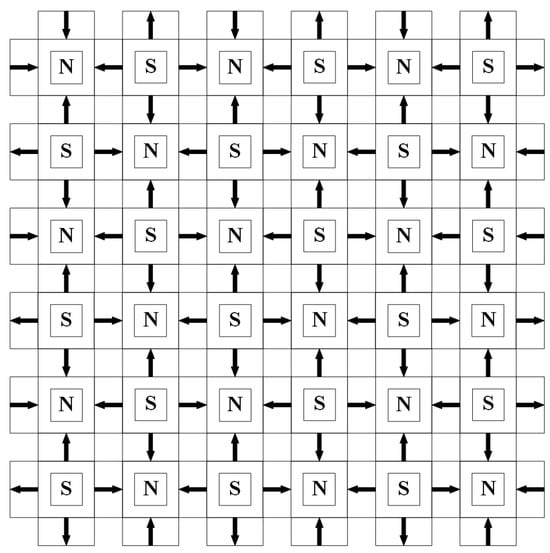
Figure 3.
Traditional Halbach array structure diagram.
The harmonic model of the magnetic field in the x, y, and z directions at the z height of the array surface is shown in Equations (1)–(3) [16]:
Among them , , are the magnetic flux density components in the x, y, and z directions, respectively, measured in Tesla (T), , , k and l represent the number of harmonics, is the polar moment of the permanent magnet platform, is the thickness of the small magnetic steel, the period:
- , , ,
- ,
- .
Using the traditional Halbach magnetic field for modeling, the actual magnetic field will produce three types of distortion. The first type is harmonic component distortion, which exists on each magnetic flux density line and superimposes higher-order harmonics on the fundamental wave. This distortion is caused by the geometric shape and natural characteristics of permanent magnets. The harmonic component existing in each X-direction magnetic flux density line will introduce non-linearity in the magnetic field, the second type is periodic distortion, periodic distortion refers to the periodic deformation or distortion in the magnetic field, so that the central position of the magnetic field changes, which may cause the magnetic field to produce different forces or effects at different locations. The third type is the peak fluctuation distortion, which will cause the unstable change of magnetic flux density, causing the extreme value of magnetic flux density to fluctuate in space, resulting in the decrease of magnetic field uniformity and the increase of asymmetry, thus affecting the control accuracy of maglev system. Simulation analysis of these three kinds of distortion will be carried out in the following simulation section.
2.2. New Halbach Array Model
The new Halbach array, which adopts the structure form of adding cylindrical magnetic steel to the original array. The permanent magnets are arranged symmetrically in the x and y directions periodically. The magnetic field magnetization intensity can be expressed as
As can be seen from the formula, , , , are periodic symbol functions, representing the periodic symmetric distribution of magnetization in the x and y directions. Ignoring the end effect of the permanent magnet array and assuming that the permanent magnet array extends to infinity in both x and y directions, the distribution of magnetization can be characterized by Fourier series.
The components of the magnetic flux density generated by Halbach permanent magnet array in the air gap in x, y, and z directions are obtained as follows:
In the preliminary work [17], we have completed the magnetic modeling of the Halbach array and verified the consistency of magnetic density generated by the Halbach array through simulation and experiments. Therefore, the next step is to combine and assemble the cylindrical correction magnet with the Halbach array to effectively correct the real magnetic field. Due to the inconsistency of magnetic steel and assembly errors, the magnetic field generated by planar permanent magnets is not a perfect periodic system. Therefore, in order to ensure model accuracy, theoretically all permanent magnets must be separately evaluated and modeled within the harmonic model cycle. On the other hand, due to the presence of yoke iron, the edge effect of permanent magnets has a more significant impact on magnetic field errors. Based on the above non ideal characteristics, it is necessary to quantify the magnetic field distribution deviation through the Poisson equation (Equation (8)), while considering the edge effect caused by the yoke Poisson’s Equation (8) can be used to calculate the magnetic field distribution generated by a permanent magnet:
Among them, represents magnetic potential, is magnetization intensity, and is the relative magnetic permeability of the source region.
The next step is how to calculate the superimposed magnetic source generated by the rectangular permanent magnet and the cylindrical modified permanent magnet in the new Halbach. For the rectangular permanent magnet, the harmonic term can be obtained by using the double integral description:
For cylindrical permanent magnets, the Simpson’s rule can be used to obtain the harmonic terms in the x and y directions: , , , :
According to the symmetry of the above formula, it can be seen that when the moving element of the maglev motion platform undergoes step by step movement or rotation, only the integral expression needs to be calculated once, without the need to re evaluate the model. This method of rotating around the local z-axis simplifies the calculation process of the entire system. Similarly, it is necessary to model the magnetic flux density of a rectangular magnet overlaid with a cylindrical magnet.
In order to analyze how cylindrical corrected permanent magnets affect Halbach permanent magnets in the air gap, we can start from the perspective of charge. An electromagnetic source generated by a point charge can be represented as
Among them, is the charge source with a point surface, is the observation point. Since the cylindrical magnetic source does not change the boundary of the Halbach rectangular magnetic source, the inverse mapping created by the charge distribution of the cylindrical permanent magnet on the permanent magnet is equivalent to
Among them, is the normal direction of the charged surface, is the angle of charge density distribution within the range of , and due to the axial symmetry of the cylinder, the rotation angle of the stator magnet will always remain outside the integral term:
Among them, the first integral defined in the cylindrical coordinate system is analytically calculated, while the second integral is numerically calculated using the Simpson rule, which is the so-called semi analytical harmonic modeling method in this article. Ultimately, we can obtain
Among them,
An important inspiration from this section is that it is feasible to correct the magnetic field by overlaying the corrected magnetic field generated by the cylindrical permanent magnet with the harmonic magnetic field generated by the rectangular Halbach permanent magnet. The corrected magnetic field can be numerically solved using Simpson’s rule, which is a semi analytical harmonic modeling method that ensures model accuracy while also having efficiency advantages.
2.3. Analytical Model of Magnetic Dipole
Based on Boyer’s 1998 current loop model, the force formula is extended and derived for non-uniform magnetic media scenarios. The forces between magnetic dipoles are functions of spatial derivatives and involve complex vector operations [18]. In the absence of analytical expressions, it often requires heavy numerical calculations to accurately calculate the force between two magnetic dipoles. Therefore, deriving a simple analytical equation can lead to a more intuitive understanding of the interaction between magnetic dipoles. We assume that the size of the dipoles is small compared to their spacing. The analytical expression of magnetic force is derived by using Taylor expansion for the first non-zero term.
The force on a magnetic dipole has previously been calculated by Boyer and Timothy [19]; however, the force of one magnetic dipole on another has not been deduced in electromagnetism textbooks or the journal literature. An analytical expression of this force is derived and given in this paper, which is suitable for cases where the dipole separations are larger than their dimensions. The path integral and vector differential methods are given here, with slightly different approximations used in both cases. Both get the same closed form result.
The path integral method is used to derive the force between two magnetic dipoles, mainly by solving the interaction between two current-carrying loops.
The magnetic force exerted by circuit a carrying current Ia on circuit b carrying current Ib is given as in [20,21].
where is the magnetic constant, I is the current of circuit a, is the current of circuit b, is the path increment vector along circuit a, is the path increment vector along circuit b, and R is the vector from circuit path element to circuit path element . This geometry is shown in Figure 4.
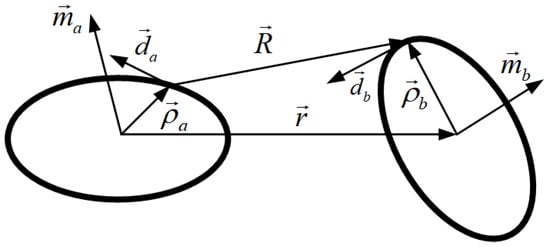
Figure 4.
Schematic diagram of the current source geometry.
The magnetic dipole moments of these two circuits are defined as
where a is a vector from the center of the magnetic dipole to the circuit element , and b is a vector from the center of the magnetic dipole to the circuit element , we assume that the magnetic dipole is a planar circular circuit. The general expression of the magnetic dipole moment is
where I is the current of a general magnetic dipole circuit, is the unit dipole moment vector, is the incremental vector along the unit path of the circuit, and is the unit vector from the center of the magnetic dipole to the circuit path element, the geometry of a magnetic dipole moment circuit as shown in Figure 5.
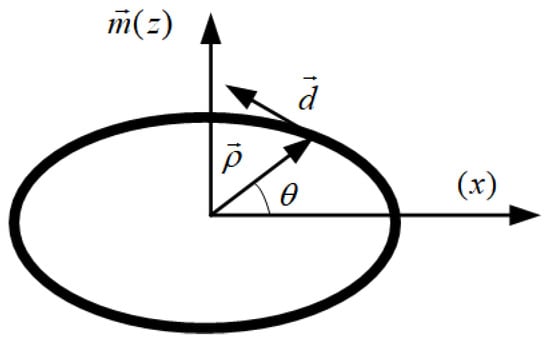
Figure 5.
Geometry of a magnetic dipole moment circuit.
The analytical expression obtained by the path integral method can be used to analyze the force between two magnetic dipoles in different geometric situations. For example, when the direction of the magnetic moment is parallel or perpendicular to the distance vector between them, the force behaves as attraction or repulsion, with a clear physical meaning. This analytical solution not only makes the calculation more concise, but also helps to understand the physical nature of the forces between magnetic dipoles and how they interact in different configurations. In summary, the path integral method deduces the analytical expression of the force between two magnetic dipoles by summing and integrating the force between the current-carrying loops and combining the far-field approximation. This method provides a more intuitive and clear mathematical tool for understanding the forces between magnetic dipoles, especially for the design and optimization of complex electromagnetic systems and materials.
The dipole force formula provides a micro mechanical basis for magnetic field correction under finite permeability.
3. Finite Permeability Model
The finite permeability model is a model used to describe the electromagnetic properties of magnetic materials with non-infinite permeability (i.e., relative permeability greater than 1 and finite values). In magnetic materials, relative permeability represents the material’s response to a magnetic field, compared to the permeability of free space. The finite permeability model is particularly suitable for magnetic materials whose permeability cannot simply be regarded as infinite, such as soft magnetic materials such as iron and nickel.
In these materials, because the permeability is not infinite, the magnetic field partially penetrates the inside of the material, rather than being completely repelled by the external magnetic field. In this case, the calculation of the magnetic field and flux distribution is more complicated than in the case where the ideal permeability is infinite, and specific mathematical methods are required to consider the field distribution inside and outside the material. When the permeability is finite, traditional analytical solutions (such as assuming that the material is an ideal conductor) are often no longer applicable, and numerical methods, such as finite element analysis (FEM), are needed to accurately calculate the electromagnetic field distribution. In order to improve the computational efficiency, this paper adopts the polynomial approximation method to model the surface charge density, so as to realize the semi-analytic calculation. In this paper, the implementation of the finite permeability model simplifies the calculation by introducing a polynomial approximation to describe the charge distribution on the surface of the material, which significantly reduces the calculation time, but reduces the accuracy to some extent. This method provides an efficient and sufficiently accurate tool for studying magnetic materials with high relative permeability, which has significant advantages in engineering applications where efficient calculation of magnetic field distributions is required.
3.1. Variable Permeability Model
In order to deal with the variable permeability, a semi-analytical method based on polynomial approximation is proposed to build the relative permeability model. Specifically, the improvement and computational optimization of the permeability model are achieved in the following ways. Firstly, an iterative model of surface charge density is introduced. In order to consider the relative permeability in the surface charge model, an iterative process is used to change the surface charge density of the material. The traditional surface charge model can only be quickly calculated when the relative permeability is 1, that is, when the permeability and vacuum are the same, analytical methods can be used. In order to consider the relative permeability of the material, this paper introduces the variable permeability by adjusting the surface charge density of the material on the basis of the original model. The calculation of charge density involves the magnetization of the material, the external magnetic field, and the interaction of other materials.
When the relative permeability is introduced, the calculation of charge density is no longer a simple analytical process, but needs to use numerical iterative method. This method has high precision, but the calculation time is long, especially for complex magnetic structures, which requires a large number of iterative steps. In order to improve the computational efficiency, this paper proposes to use polynomial approximation to represent the surface charge density, thereby transforming the complex numerical iterative calculation into semi-analytic form. The surface charge density is approximated as a subpolynomial:
where, is the coefficient of the polynomial, which are obtained by fitting the magnetic field distribution. With this approximation, the complex distribution of charge density can be represented by polynomials, making subsequent magnetic field calculations much simpler.
By analyzing the convergence of errors and balancing engineering efficiency, the value of n is determined as shown in Table 1. Based on the actual charge density on the surface of the Halbach array of the self-developed magnetic levitation planar motor (calculated by high-precision finite element method FEM, with a grid size of 0.001 mm, considered as the true value), the root mean square error (RMSE) of polynomial approximation and the maximum error in the edge region (E-max) are defined as evaluation indicators (the edge region refers to the range of ±2 mm from the edge of the magnet, where the distortion of charge density is most significant). The motor magnet structure parameters used in this article are matched; fixed magnet size, gradually increasing n (from 1 to 8), and recording the error changes at each iteration; when n = 4, the RMSE decreases to 0.021 C/m2 (<0.03 C/m2, meeting engineering accuracy requirements), and the E-max decreases to 0.038 C/m2 (<0.04 C/m2); when n continues to increase to 5, the RMSE only drops to 0.020 C/m2 (a decrease of 4.8%), but the polynomial coefficient solving time increases from 0.08s to 0.15s (an increase of 87.5%), resulting in a serious mismatch between accuracy improvement and efficiency loss. Therefore, this study ultimately chose n = 4 as the highest degree of the polynomial.

Table 1.
Relationship between polynomial order n and approximation error.
After the polynomial approximation of the charge density, the calculation of the magnetic field no longer requires complex numerical integration for each surface element, but can be analytically calculated for each term of the polynomial. Specifically, the magnetic field can be expressed as a superposition of the magnetic field contributed by each polynomial coefficient:
This form simplifies the calculation of the magnetic field to the independent calculation and summation of each polynomial term, thus realizing the semi-analytical calculation. Due to the use of polynomials for approximation, some errors may occur in the material edge region, especially when the charge density varies dramatically at the edge. By comparing the polynomial approximation with the finite element method (FEM), it is found that although there are some errors, the calculation accuracy is still acceptable on the whole. The most significant advantage is that the calculation time is significantly reduced compared to the complete numerical iterative method, so it is suitable for use in applications with high requirements for calculation speed.
In summary, the process of establishing the variable permeability model is to make a polynomial approximation of the surface charge density, so that for materials with relative permeability different from 1, the calculation efficiency can be greatly improved while maintaining reasonable accuracy. The introduction of polynomial approximation simplifies the complex model that needs iterative numerical solution to a semi-analytical model, thus effectively balancing the contradiction between computational accuracy and efficiency.
3.2. Scalar Potential Energy Solution
In this section, the model derived from the magnetic couple modeling is used to solve the scalar potential energy.
Scalar potential energy is the core physical quantity that describes the energy of interaction between permanent magnets, and its primary function is to provide a basis for force and torque calculation in modeling permanent magnet interaction. This calculation is based on the equivalent charge model, especially suitable for describing magnetic field and force distribution in complex three-dimensional systems, and its expression needs to include the contributions of surface magnetic charge density and bulk magnetic charge density at the same time.
Magnetization vector can represent the magnetic dipole distance per unit volume, the surface magnetic charge density is determined by the magnetic vector on the surface method of the component, it is one of the main sources of magnetic field, its distribution determines the shape of the external magnetic field, in fact, in addition to the surface magnetic charge density, in non-uniform magnetized materials, the body magnetic charge density is also an important source of magnetic field, It can be defined in terms of the divergence of the magnetization vector. The magnetic field obtained by this analysis method can become the external magnetic field of the surface:
where V is the volume integration region, S is the surface integration region, r is the position vector of the magnetic charge.
The analytical method is usually only applicable to simple geometry and boundary conditions, and is solved by converting the Poisson equation into a series of ordinary differential equations using the method of separating variables or the Fourier transform. Relatively speaking, the numerical method is more suitable for complex geometry, and the continuous equation is discretized into algebraic equation to solve the magnetic potential distribution. For complex dipole arrays, the scalar potential of each dipole can be superimposed and the total field can be calculated by numerical integration. The results of the polynomial approximation model are compared with those of the numerical method, and the tradeoff between the calculation speed and accuracy of the model is demonstrated.
4. Simulation Analysis
4.1. Comparison Simulation of Magnetic Field of New Halbach Array
The analytical model of the magnetic field of a permanent magnet array can be expressed in the form of Equation (24):
In the formula, . The analytical model of prototype array magnetic field is established by using mathematical software, , = 60 mm, , , 40 mm. Take z = 2 mm and z = 5 mm, respectively. The model parameters are shown in Table 2.

Table 2.
Model parameter table.
According to the comprehensive simulation results, there is a big difference between the actual magnetic field and the theoretical magnetic field. The reason for the peak fluctuation may be the square vacancy in the magnetic steel array. The decrease of the magnetic field strength at the vacancy results in the decrease of the extreme value, which will cause the direction change during the motion of the actuator, and cause the fluctuation of force and moment, causing the up and down vibration of the actuator and affecting the positioning accuracy. Then, the improved Halbach array and the prototype array are simulated by using the half-harmonic modeling method.
4.2. Simulation of Semi-Analytic Harmonic Model
COMSOL Multiphysics 6.1 was used to complete the modeling of the prototype permanent magnet array. In addition, in order to ensure that the simulation results were close to the experimental situation, the mesh of the model was extremely refined to improve the reliability and accuracy of the results.
The analytical model obtained by mathematical tools is shown in Figure 6. At the position Z = 2 mm, the maximum magnetic flux density of Bx and By is 0.64 T, and the maximum magnetic flux density of Bz is 1.28 T; At Z = 5 mm, Bx has a maximum magnetic flux density of 0.51 T with By, and Bz has a maximum magnetic flux density of 1.02 T. With the same magnet pole distance, magnet thickness, and magnetization, the old array at Z = 2 mm has a maximum magnetic flux density of 0.59 T from Bx and By and a maximum magnetic flux density of 1.18 T from Bz; at Z = 5 mm, the maximum magnetic flux density of Bx to By is 0.47 T, and the maximum magnetic flux density of Bz is 0.95 T.
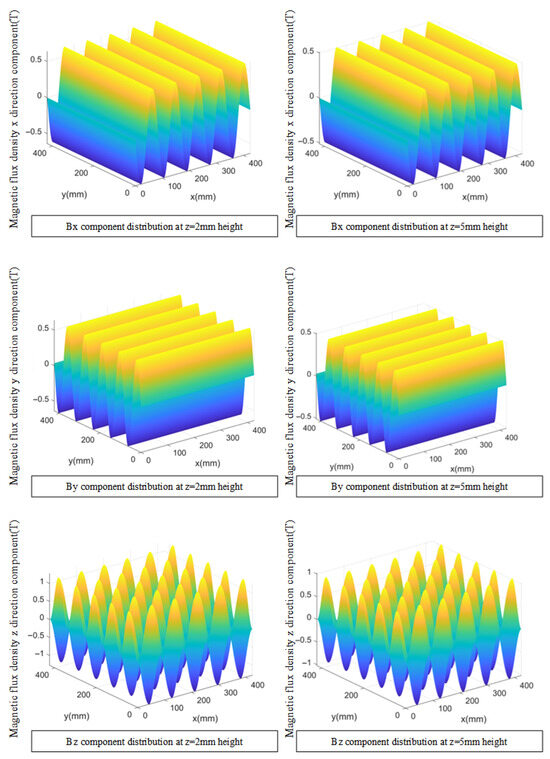
Figure 6.
Distribution of magnetic flux density components of the new Halbach array at different heights.
COMSOL Multiphysics simulation software was used to simulate the magnetic field of the prototype array, and the simulation data was imported into the mathematical software for the three-dimensional space magnetic flux density waveform analysis. The differences between the theoretical magnetic field and the actual magnetic field were verified and summarized, and the reasons for the differences were analyzed according to the structural characteristics of Halbach permanent magnet array.
It is found that the periodic distortion of the magnetic field after improvement is indeed reduced. Compared with the Bx scan height of 5 mm, it can be found that the honeycomb structure of the magnetic steel array has less distortion. However, when the magnetization of the magnetic steel of the relative position is the same, the prototype array is 5 mm high T, T while the improved Halbach array loses a certain field intensity T, but the distribution is more uniform and smooth. The original structure contains large boundary errors or high frequency components, which are essentially reduced by constrained optimization.
To verify the efficiency advantage of the proposed semi analytical harmonic modeling method, we took the 6-degree-of-freedom Halbach array (including 128 permanent magnets, with size parameters of the magnetic levitation planar motor core as the modeling object, and compared the computational time of the proposed method with COMSOL Multiphysics 6.1 (FEM) under the same hardware environment (Intel Core i7-12700K processor (Intel Corporation, Santa Clara, CA, USA), 32 GB memory (Kingston Technology Corporation, Fountain Valley, CA, USA)). The specific data is shown in Table 3.

Table 3.
Comparison of calculation time between the proposed method and FEM.
FEM adopts adaptive grid division, with a minimum grid size of 0.5 mm (to ensure accuracy convergence); The selection of harmonic order in the proposed method is based on error convergence analysis. When k = l ≥ 20, the calculation error of magnetic field strength is less than 0.5%, which meets the engineering accuracy requirements.
The above data clearly shows that the calculation time of the proposed method increases slowly with the modeling dimension and harmonic order, while FEM’s time increases exponentially due to discretization requirements. Especially in the dynamic magnetic field update scenario (corresponding to the real-time control requirements of the 1.5 m/s high-speed motion of the maglev platform), the proposed method takes only 0.012 s for single step update, far lower than the 45.2 s of FEM.
The horizontal axis in Figure 7 represents the harmonic order (k/l), with a range of 1–15 (step size 1), covering the complete convergence process from low order to high order; the vertical axis represents the relative error of magnetic field calculation (unit:%), and the analysis object is the z-direction magnetic field located 10mm directly above the Halbach array of the independently developed magnetic levitation planar motor (consistent with the experimental measurement point position). The error calculation benchmark is the 30th harmonic analytical solution (considered as the true value). From the trend of the curve, it can be seen that the influence of harmonic order on calculation error presents a “two-stage” characteristic: Rapid decline segment (k/l = 1–8): As the harmonic order increases from 1 to 8, the relative error drops sharply from 8.2% to 0.48%, with a decrease of 94.1%. The introduction of high-order harmonics in this stage significantly compensates for the neglect of high-frequency components in the magnetic field by low order models, especially improving the calculation deviation of magnetic field distortion at the edge of the magnet, which is consistent with the trend of magnetic field distribution deviation measured by Hall sensors in experiments; Convergence plateau (k/l > 8): When the order exceeds 8, the downward trend of error slows down significantly. When the order increases from 8 to 15, the error only decreases from 0.48% to 0.32%, with a decrease of only 33.3%. This indicates that the contribution of high-order harmonics to accuracy has reached saturation, and further increasing the order will lead to unnecessary increase in computational complexity (the calculation time at order 30 is 172% higher than that at order 8), while the improvement in accuracy is limited. The black error bars in the figure represent the standard deviation of three repeated calculations (range ± 0.05% ±0.12%), reflecting the reliability of the data; the red label clearly states that ‘when k/l = 8, the error is 0.48%’, and the model at this order satisfies both the ‘engineering accuracy requirement of error < 0.5%’ and the ‘optimal computational efficiency’. Therefore, k/l = 8 is determined as the optimal harmonic truncation order.
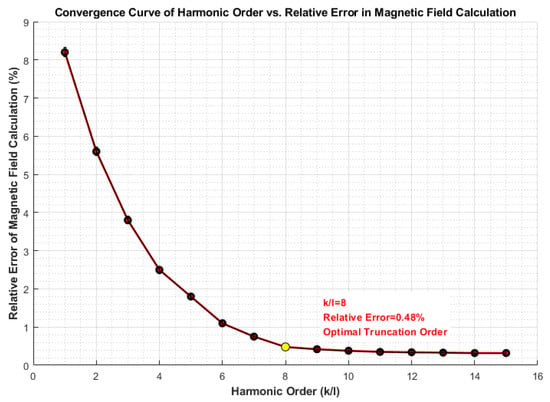
Figure 7.
Convergence curve of harmonic order vs. relative error in magnetic field calculation. The red line represents the overall trend of the relative error between harmonic order (k/l) and magnetic field calculation. The black dots mark the original average error data points corresponding to 15 harmonic orders, and the yellow dots indicate that when k/l = 8, the error is 0.48%. This order model meets the engineering accuracy requirement of error < 0.5% and the optimal computational efficiency.
COMSOL FEM (after grid convergence verification) and experimental measurement data are used as dual accuracy benchmarks. FEM was validated for grid independence (with a minimum grid size of 0.5 mm and a magnetic field strength deviation of <0.3%). The experiment used a three-axis precision motion platform (positioning accuracy ± 0.01 mm) equipped with Hall sensors (accuracy ± 1 mT) to measure the magnetic field distribution. Select COMSOL FEM (with the same grid accuracy) and traditional analytical methods as the efficiency comparison benchmark to ensure fairness in comparison conditions.
Taking the Halbach array constructed with the parameters as an example, 100 uniformly distributed measurement points were selected in the x-y plane at heights of z = 2 mm and z = 5 mm. The deviation between the proposed method, FEM, and experimental data was compared.
The data shows that the maximum relative error between the proposed method and experimental data is ≥3.67%, and the deviation from FEM is ≥1.92% in Table 4. However, the maximum relative error of the traditional equivalent charge method exceeds 10%, which fully proves that the accuracy of the proposed method is significantly better than that of the equivalent charge method and is basically on par with high-precision FEM. In this study, the maximum relative error is ≥3.67%, and its relative benchmark is the “theoretical design magnetic field intensity average value of the self-developed Halbach array magnetic levitation planar motor”. The specific calculation method is: relative error = |measured value − theoretical average value|/theoretical average value × 100%.

Table 4.
Deviation between the proposed method, FEM, and experimental data.
Continuing with the aforementioned hardware environment, taking 3D magnetic field modeling as an example, compare the core efficiency indicators of three methods as shown in Table 5.

Table 5.
Compare the core efficiency indicators of three methods.
The equivalent charge method has slightly higher efficiency, but much lower accuracy than the proposed method; The proposed method improves efficiency by multiple times while approaching FEM accuracy, achieving the unity of “high precision high efficiency”, which traditional methods cannot balance. In the complete engineering application scenario, the equivalent charge method requires additional error correction, and the total time (3.84 s) is significantly higher than the proposed method (1.45 s), with lower efficiency.
The 0.02 mm step size is the optimal integration step size used in this study, which balances calculation accuracy (error < 0.2%) and efficiency (calculation time < 0.4 s), and meets the experimental measurement accuracy requirements of magnetic levitation planar motors (Hall sensor measurement error ± 0.5%) which as shown in Table 6.

Table 6.
Relationship between Simpson’s integration step size and relative error.
Figure 8 takes the Halbach array of independently developed magnetic levitation planar motor as the research object, and compares and displays the z-direction magnetic field distribution in the x-y plane 10 mm above the Halbach array of the motor before and after optimization. The color bar on the right indicates the range of magnetic field intensity (0.2–0.8T), and the darker the color, the higher the magnetic field intensity, ensuring the consistency of the comparison benchmark between the two subgraphs. The local deviation of the magnetic field before optimization reached ±0.05T, and after optimization it decreased to ±0.015T, with a uniformity improvement of 65%. All comparison results are based on measured data from Hall sensors, clearly verifying the improvement effect of array structure optimization on the magnetic field performance of the magnetic levitation motor.
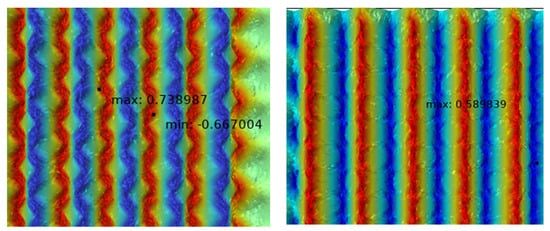
Figure 8.
Comparison of magnetic field distribution after optimization of array structure.
5. Experimental Verification
5.1. Experimental Setup
The self-developed Hall sensor used in this experiment has an inherent measurement accuracy of ±1 mT, which is used to ensure controllable instrument errors for a single measurement; the average absolute deviation between the measured and calculated values in the experiment is 0.028 T, which is a total deviation that combines the edge magnetic field distortion of the Halbach array of the magnetic levitation motor (±15 mT), the micro vibration of the experimental platform (±8 mT), and the inherent error of the instrument (±1 mT).
Perform 10 repeated measurements (eliminating random interference) on 20 measurement points (including 5 edge points and 15 center area points) located 10 mm above the Halbach array of the motor. The measurement data conforms to a normal distribution (Shapiro–Wilk test p = 0.87 > 0.05).
The experimental equipment adopts a three-axis motion system for precise positioning, hereinafter referred to as the three-degree-of-freedom sliding table. The main purpose of this device is to realize the accurate movement of Hall sensors in space (XYZ direction) in order to detect or generate magnetic field distribution, so as to realize the design verification experiment and adjustment of the magnet array. The device can also be used for calibration of magnetic sensors, testing of magnetic properties of materials, optimization of electromagnetic devices and other experiments in the later stage in Figure 9.

Figure 9.
Three-axis precision motion table for magnetic field scanning.
Before the experiment, it is necessary to calibrate the starting position of the three axes of XYZ through the absolute zero laser sensor to ensure the accuracy of the motion. Then fix the Hall sensor on the slide platform and ensure that the axis of the Hall sensor is aligned with the axis of the slide platform. G code is used to plan the moving path of the sliding table, and the moving step size of the sliding table is adjusted according to the requirements of the magnetic field resolution. The slide then operates in sync with Hall sensors, recording magnetic field strength or direction data in real time at each location. Finally, in order to improve the accuracy of the experimental data, multiple measurements are needed to eliminate the noise error. The three-degree-of-freedom sliding table is widely used in basic research and engineering applications related to magnetic field by combining high-precision positioning with magnetic field measurement equipment. In practice, the magnetic field distribution measurement with high resolution and high efficiency can be realized by precisely planning the motion path of the slide table and optimizing the data acquisition strategy, which provides reliable technical support for related experiments.
5.2. Experimental Results
The waveforms obtained at different heights of the same transsection of the two arrays are shown in Figure 10 and Figure 11. It can be seen that the magnetic flux density of the new array is greatly improved, at least 23% higher than that of the original array, and the distorted waveform has better regularity and smaller extreme value difference.
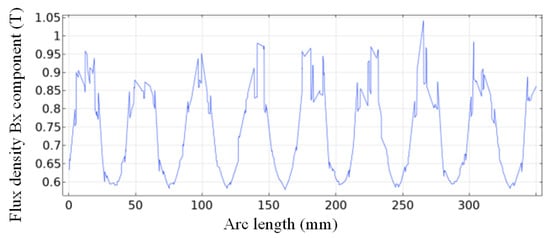
Figure 10.
New array simulation results (simulation height 2 mm).
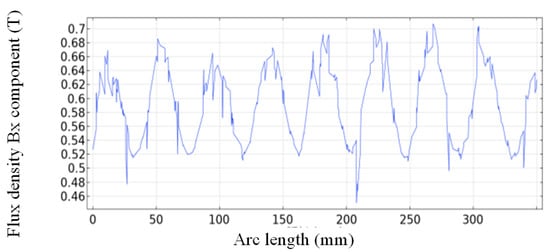
Figure 11.
New array simulation results (simulation height 5 mm).
It can be seen from the data in Table 7 that the standard deviation of magnetic field waveform distribution of the new array is slightly smaller than that of the prototype array at different air gap heights, and has smaller extreme value differences. The dispersion coefficient is the ratio of standard deviation to the mean value, which is used to evaluate the dispersion degree of data with different mean values. The smaller the dispersion coefficient, the smaller the dispersion degree of data. Using the dimensionless discrete coefficient as an index to evaluate the peak fluctuation distortion of the magnetic field in the non-scanning direction has the advantage that it is not necessary to refer to the average value of the data when analyzing the magnetic field distortion of the magnetic steel with different structural parameters, such as the magnetic steel with different thickness, pole moment and air gap height in the future. If the thickness of the magnetic steel is small or the polar moment is small, the standard deviation of the waveform data will be reduced with the mean value. If the standard deviation is simply analyzed, the actual situation of peak fluctuation distortion cannot be reflected.

Table 7.
Non-scan direction distortion analysis data.
When the air gap height of the prototype array is 2 mm, the data dispersion coefficient is 18.87%, and that of the new array is 14.63%. When the air gap height is 5 mm, the dispersion coefficient of the prototype array is 12.48%, and that of the new array is 9.50%. It can be seen that the new array has an obvious correction effect on the non-scanning direction peak fluctuation distortion of the magnetic flux density waveform.
6. Conclusions
The magnetic field modeling technique based on semi-analytic harmonic modeling method is discussed, especially the optimization design and verification of complex magnetic field distribution and new Halbach array. The aim of this research is to solve the tradeoff between accuracy and computational efficiency of traditional magnetic field modeling methods, and to provide an efficient and accurate modeling tool for complex magnetic field design. The semi-analytic harmonic modeling method overcomes the problem of long calculation time of the traditional finite element method (FEM), and is superior to the analytical method and the equivalent charge method in modeling accuracy, which has significant advantages in efficiency and accuracy. The proposed method is not only suitable for the modeling of planar permanent magnet arrays, but also provides a new solution for other complex magnetic field problems, such as non-uniform materials and nonlinear systems. The experimental results show that compared with the traditional modeling methods, the optimized Halbach array has more uniform magnetic field distribution, and the peak fluctuation is reduced by about 20–30%. The cost is that the magnetic field strength is slightly reduced, but the uniformity and stability are greatly improved. The dispersion coefficient decreased from 18.87% of the original array to 14.63% of the optimized array (2 mm height) and from 12.48% to 9.50% of the optimized array (5 mm height).
Author Contributions
Conceptualization, Y.Z. and C.F.; methodology, Y.Z.; software, Y.Z.; validation, Y.Z., C.F. and C.Y.; formal analysis, Y.Z.; investigation, Y.Z.; resources, Y.Z.; data curation, Y.Z.; writing—original draft preparation, Y.Z.; writing—review and editing, Y.Z.; visualization, Y.Z.; supervision, Y.Z.; project administration, Y.Z.; funding acquisition, Y.Z. and C.Y. All authors have read and agreed to the published version of the manuscript.
Funding
This work was supported in part by Supported by special fund of Overseas Leading Talents Project of Ministry of Science and Technology (220/20230005) and Supported by special funds for supporting national leading talents of Shandong Province (2023GJJLJRC-077) and Special Supporting Funds for Leading Talentsabove Provincial Level in Yantai (220/820202) and the Postdoctoral Fellowship Program of CPSF (Grant No. GZC20233485) and the Natural Science Foundation of Heilongjiang Province, China (LBH-Z23186).
Data Availability Statement
Data will be made available on request.
Conflicts of Interest
The authors declare no conflicts of interest.
References
- Klocke, F.; Beck, T.; Hoppe, S.; Krieg, T.; Müller, N.; Nöthe, T.; Raedt, H.W.; Sweeney, K. Examples of FEM application in manufacturing technology. J. Mater. Process. Technol. 2002, 120, 450–457. [Google Scholar] [CrossRef]
- Beskos, D. Boundary Element Methods in Dynamic Analysis. Appl. Mech. Rev. 1987, 40, 1–23. [Google Scholar] [CrossRef]
- Pipa, A.V.; Koskulics, J.; Brandenburg, R.; Hoder, T. The simplest equivalent circuit of a pulsed dielectric barrier discharge and the determination of the gas gap charge transfer. Rev. Sci. Instruments 2012, 83, 115112. [Google Scholar] [CrossRef] [PubMed]
- Ou, T.; Hu, C.; Zhu, Y.; Zhang, M. Generation Mechanism and Decoupling Strategy of Coupling Effect in Maglev Planar Motor. IEEE/ASME Trans. Mechatronics 2023, 28, 781–791. [Google Scholar] [CrossRef]
- Cho, H.-S.; Im, C.-H.; Jung, H.-K. Magnetic field analysis of 2-D permanent magnet array for planar motor. IEEE Trans. Magn. 2001, 37, 3762–3766. [Google Scholar]
- Zhang, X.; Mehrtash, M.; Khamesee, M.B. Dual-axial motion control of a magnetic levitation system using Hall-effect sensor. IEEE/ASME Trans. Mechatronics 2016, 21, 1129–1139. [Google Scholar] [CrossRef]
- Compter, I.J.C. Electro-dynamic planar motor. Precis. Eng. 2004, 28, 171–180. [Google Scholar] [CrossRef]
- de Boeij, J.; Lomonova, E.; Vandenput, A. Modeling Ironless Permanent-Magnet Planar Actuator Structures. IEEE Trans. Magn. 2006, 42, 2009–2016. [Google Scholar] [CrossRef]
- Jansen, J.W.; van Lierop, C.M.M.; Lomonova, E.A.; Vandenput, A.J.A. Modeling of magnetically levitated planar actuators with moving magnets. IEEE Trans. Magn. 2007, 43, 15–25. [Google Scholar] [CrossRef]
- Rovers, J.M.M.; Jansen, J.W.; Lomonova, E.A. Multiphysical analysis of moving-magnet planar motor topologies. IEEE Trans. Magn. 2013, 49, 5730–5741. [Google Scholar] [CrossRef]
- de Boeij, J.; Lomonova, E.A.; Duarte, J.L. Contactless planar actuator with manipulator: A motion system without cables and physical contact between the mover and the fixed world. IEEE Trans. Ind. Appl. 2009, 45, 1930–1938. [Google Scholar] [CrossRef]
- Lu, X.; Usman, I.U.R. 6D direct-drive technology for planar motion stages. CIRP Ann.-Manuf. Technol. 2012, 61, 359–362. [Google Scholar] [CrossRef]
- Beyer, P.; Benkadda, S.; Garbet, X. Proper orthogonal decomposition and Galerkin projection for a three-dimensional plasma dynamical system. Phys. Rev. E 2000, 61, 813–823. [Google Scholar] [CrossRef] [PubMed]
- Genesio, R.; Tesi, A. Harmonic balance methods for the analysis of chaotic dynamics in nonlinear systems. Automatica 1990, 28, 531–548. [Google Scholar] [CrossRef]
- Halbach, K. Design of permanent multipole magnets with oriented rare earth cobalt material. Nucl. Instruments Methods 1980, 169, 1–10. [Google Scholar] [CrossRef]
- Zuidema, G.; Krop, D.C.J.; Lomonova, E.A. Semi-Analytical Modeling of a PM-based 6-DOF Actuator. In Proceedings of the 2021 Sixteenth International Conference on Ecological Vehicles and Renewable Energies, Monte-Carlo, Monaco, 5–7 May 2021. [Google Scholar]
- Yu, X.; Liu, E.; Fan, C.; Zhao, B.; Tan, J. Honeycomb Halbach Flexible Permanent Magnet Array for Magnetically Levitated Planar Motor. IEEE Trans. Magn. 2025, 61, 4900109. [Google Scholar] [CrossRef]
- Landecker, P.B.; Villani, D.D.; Yung, K.W. An Analytic Solution for the Torque Between Two Magnetic Dipoles. Magn. Electr. Sep. 1999, 10, 29–33. [Google Scholar] [CrossRef]
- Boyer, T.H. The force on a magnetic dipole. Am. J. Phys. 1998, 56, 688–692. [Google Scholar] [CrossRef]
- Kou, B.; Zhang, L.; Li, L.; Zhang, H. Modeling and analysis of a magnetically levitated synchronous permanent magnet planar motor. J. Appl. Phys. 2012, 111 Pt 3, 5. [Google Scholar] [CrossRef]
- Hu, C.; Wang, Z.; Zhu, Y.; Zhang, M.; Liu, H. Performance-oriented precision LARC tracking motion control of a magnetically levitated planar motor with comparative experiments. IEEE Trans. Ind. Electron. 2016, 63, 5763–5773. [Google Scholar] [CrossRef]
Disclaimer/Publisher’s Note: The statements, opinions and data contained in all publications are solely those of the individual author(s) and contributor(s) and not of MDPI and/or the editor(s). MDPI and/or the editor(s) disclaim responsibility for any injury to people or property resulting from any ideas, methods, instructions or products referred to in the content. |
© 2025 by the authors. Licensee MDPI, Basel, Switzerland. This article is an open access article distributed under the terms and conditions of the Creative Commons Attribution (CC BY) license (https://creativecommons.org/licenses/by/4.0/).